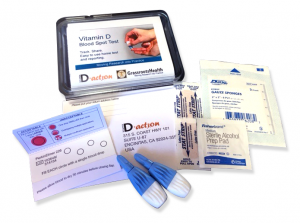Published on January 28, 2025
Dr. Michael Holick presents a 2024 Perspective and Response to Endocrine Society Vitamin D Guideline Updates
Key Points
- In this presentation, Dr. Holick offers a quick review of vitamin D studies, including observational and association-type studies, and very clearly demonstrates the observed benefits of achieving and maintaining vitamin D levels higher than those recommended by the latest Endocrine Society vitamin D guidelines update
- He reviews the history of vitamin D recommendations and discusses key points from the IOM report, the VITAL study, and the Endocrine Society guidelines and how they continue to miss the mark
- Vitamin D deficiency remains the most common medical condition, in part due to confusing and misguiding recommendations
In today’s featured video presentation, Dr. Michael Holick, Ph.D., M.D. dives into the evolving guidelines set for vitamin D and touches on its crucial role in maintaining health from early life to later years. He reviews the history of vitamin D recommendations and discusses key points from the IOM report, the VITAL study, and the Endocrine Society guidelines and how they continue to miss the mark. From the latest 2024 Endocrine Society updates to published findings on its impact on bone health, immunity, and chronic diseases, this discussion is a must-watch for anyone interested in better understanding what to do about vitamin D among many confusing headlines and guidelines.
Watch the Video
This presentation was part of the 2024 International Virtual Vitamin D Forum & Expert Panel Discussion. Access the recorded event and additional presentations here.
Learn more and access his published response here.
Key Topics from the Video
3:48 – 5:34
Discussing 2024 ES Guidelines
- assumed the recommendations made by the 2010 IOM panel was correct
- depended only on Randomized Controlled Trials (RCTs) and ignored association studies
5:35 – 7:24
Vitamin D Recommendations for Pregnant Women: Are they enough?
- Are pregnant women at risk of vitamin D deficiency, even when taking a prenatal vitamin? And drinking milk?
- 76% of mothers and 81% of Newborns were still below 20 ng/ml!
- Why does this matter? Lower vitamin D levels are associated with increased risk of preeclampsia, cesarean section, preterm birth, dental caries in babies…
8:07 – 11: 21
How do you define vitamin D deficiency?
- PTH levels decline until about 30-40 ng/ml
- lower levels of vitamin D will increase PTH
- presence of osteomalacia or osteoidosis and risk of fractures
11:21 -13:06
Discussion of VITAL trial
- what went wrong with the VITAL trial? Are the conclusions for bone health shared reliable?
13:6 – 14:16
Can vitamin D reduce risk of respiratory infections?
14:17 – 15:00
Can vitamin D affect risk of Type 2 Diabetes?
16:03 – 17:16
Vitamin D and Mortality
- will taking vitamin D increase your risk of death?
- What level of vitamin D is healthy?
17:59 – 19:01
Health benefits of vitamin D association and other studies
- What is the reduced risk of disease when vitamin D levels are between 40-60 ng/ml?
Vitamin D deficiency is the MOST COMMON medical condition!
When it comes to vitamin D, there’s no one-size-fits-all approach. To achieve and maintain a healthy vitamin D level of at least 40-60 ng/ml, it’s essential to determine your personalized daily dose. This ensures that your body gets the right amount of vitamin D for optimal health, helping support immune function, bone health, and overall wellness.
Are you unsure of your ideal daily vitamin D dose? Our Vitamin D*Calculator is a great tool to get started! By entering a few details along with your current vitamin D levels, you can get a tailored recommendation for your daily dosage.
Learn more about vitamin D and how to apply it to your health, and sign up to receive a short series of free email lessons, here.
About Dr. Holick
 Dr. Michael Holick is a world-renowned pioneer of vitamin D research. He is a Diplomate of the American Board of In-ternal Medicine, a Fellow of the American College of Nutrition, and a member of the American Association of Physicians. He is the recipient of numerous awards and honors, including the General Clinical Research Centers Program Award for Excellence in Clinical Research from NIH, American College of Nutrition’s Communication Media Award, Best Docs in America, the Linus Pauling Functional Medicine Award from the Institute for Functional Medicine and the Linus Pauling Prize for Human Nutrition. Dr. Holick serves on a number of national committees and editorial boards and has organized and/or co-chaired several international symposia. He served as the chair for the Endocrine Society’s Practice Guidelines on Vitamin D. He has authored more than 400 peer-reviewed publications, and written more than 200 review articles, as well as numerous book chapters.
Dr. Michael Holick is a world-renowned pioneer of vitamin D research. He is a Diplomate of the American Board of In-ternal Medicine, a Fellow of the American College of Nutrition, and a member of the American Association of Physicians. He is the recipient of numerous awards and honors, including the General Clinical Research Centers Program Award for Excellence in Clinical Research from NIH, American College of Nutrition’s Communication Media Award, Best Docs in America, the Linus Pauling Functional Medicine Award from the Institute for Functional Medicine and the Linus Pauling Prize for Human Nutrition. Dr. Holick serves on a number of national committees and editorial boards and has organized and/or co-chaired several international symposia. He served as the chair for the Endocrine Society’s Practice Guidelines on Vitamin D. He has authored more than 400 peer-reviewed publications, and written more than 200 review articles, as well as numerous book chapters.
How Are Your Levels of Vitamin D and Other Important Nutrients?
Check your vitamin D, omega-3s, magnesium, and other important markers today as part of the vitamin D*action project!
Measure your:
- Vitamin D
- Magnesium PLUS Elements (including zinc, copper, selenium, mercury, cadmium and lead)
- Omega-3 Fatty Acids
- hsCRP (for Inflammation)
- HbA1c (for Blood Sugar)
- and more
Did you know that each of the above can be measured at home using a simple blood spot test? As part of our ongoing research project, you can order your home blood spot test kit to get your levels, followed by education and steps to take to help you reach your optimal target levels. Start by enrolling and ordering your kit to measure each of the above important markers, and make sure you are getting enough of each to support better health and wellbeing!
Start Here to Measure Your Levels






